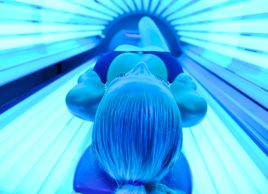Don’t be fooled: Indoor tanning isn’t pretty
Research has found that the use of indoor tanning equipment before the age of 35 increases an individual’s risk of developing melanoma by 75 percent. Here’s more on why this country needs legislation

Source: Best Health Magazine, May 2012
You’ve probably seen the roadside signs with giant fluorescent letters advertising ‘Special: New clients get three tans for $3!’ or ‘Unlimited tanning for one low monthly price!’ In fact, there scarcely goes a day when we don’t see ads for indoor tanning. They’re in magazines, bus shelters, newspapers and online banners, not to mention those pesky Facebook ads. But indoor tanning is not as safe as advertisers would have you believe.
In 2009, a report from the World Health Organization’s International Agency for Research on Cancer (WHO’IARC) announced that the agency had moved indoor tanning to its highest cancer risk category”carcinogenic in humans.’ This puts indoor tanning alongside 107 other cancer-causing substances like tobacco, arsenic, radon and plutonium!
The IARC also reported the scientific evidence linking indoor tanning to melanoma to be ‘sufficient and compelling.’ Extensive research has shown that melanoma, the most serious form of skin cancer, is caused by excessive exposure to ultraviolet (UV) rays from both the sun and indoor tanning equipment. One fact advertisers may have forgotten to tell Canadians is that some indoor tanning equipment can emit UV rays that are five times more concentrated than the sun during peak hours. In fact, it is estimated that about 90 percent of melanomas are associated with severe UV exposure and sunburn.
A 2006 analysis study conducted by an IARC working group, entitled ‘The association of use of sunbeds with cutaneous malignant melanoma and other skin cancers: A systematic review,’ found that the use of indoor tanning equipment before the age of 35 increases an individual’s risk of developing melanoma by 75 percent. While it is impossible to completely avoid sun exposure, it is very easy to avoid the use of indoor tanning equipment and by doing so greatly reduce your risk of developing skin cancer, which is a preventable disease.
Common myths
Advertisers often make claims that indoor tanning is a safe way to tan; in truth, no tan is a safe tan, regardless of whether it’s obtained indoors or out. At most, a tan provides a sun protection factor (SPF) of two to four, which is not enough to protect you while you’re outside. Research has shown that the regular use of indoor tanning equipment causes photoaging of the skin and irreparable DNA damage, as well as melanoma. Melanoma can result in disfigurement following the excision of malignant tumours from the skin and even death if it’s not detected and treated early.
The arguments have also been made that indoor tanning will help to solve vitamin D deficiencies, which are prevalent among Canadians. As it happens, most Canadians receive enough UVB radiation during sunny months through incidental exposure to produce the amount of vitamin D needed to maintain healthy levels. During the winter months, the Canadian Dermatology Association (CDA), along with Health Canada and WHO, recommends taking a daily vitamin supplement or making dietary changes to increase vitamin D levels.
It is the position of the CDA that, in the interest of protecting young Canadians, the government institute formal regulations regarding access to indoor tanning equipment. Tanning advocates argue legislation is not a reasonable means to regulate indoor tanning and that a system of parental consent is more suitable and in line with current practices. However, a 2008 study by the Canadian Cancer Society found 60 percent of tanning facilities didn’t ask customers for proof of age.
In early 2011, the city of Victoria passed a landmark bylaw in Canada making it illegal for those under the age of 18 to use tanning beds. In May 2011, the province of Nova Scotia followed suit and imposed province-wide legislation to ban teens from using tanning salons. Formal legislation is also being pushed for in Alberta, Ontario, Quebec and Manitoba. There is some progress, but Canada is falling behind; countries that have a ban in place for teens at the national level are France (1997), Scotland (2008), Austria (2009), Germany (2009) and the United Kingdom (2010).
The government must address the issue of access to indoor tanning equipment by introducing legislation as it did for both alcohol and tobacco. As for any known carcinogen, Canadian children and adolescents should be protected from UV radiation emitted by tanning beds. To that end, a private member’s bill was introduced in Parliament at the close of the winter session calling for stricter labelling of tanning equipment as well as restrictions on access to the equipment for those under age 18. The CDA fully supports this initiative, and on Melanoma Monday (May 7), the CDA, along with media partner Best Health magazine, will hold an awareness event on Parliament Hill. The hope is that this bill will become legislation in the next year.
Editor’s Note
Best Health magazine is proud to be a vocal supporter of legislation to ban tanning beds for teens in Canada. We’ve been passionate about the importance of sun safety since 2008 when the magazine launched, and in our May 2009 issue we called our readers to action in the article, ‘Let’s Outlaw Tanning Beds For Teens.’ It’s encouraging to see that real progress continues to be made in Canada, but we can still do more. Let your MP know that you support the new proposed legislation.
This article was originally titled "Don’t be fooled: Indoor tanning isn’t pretty" in the May 2012 issue of Best Health. Subscribe today to get the full Best Health experience’and never miss an issue!




